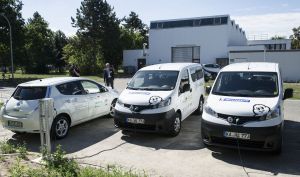RheinMobil is aimed at demonstrating that certain utilization profiles allow for an economically efficient operation of electric vehicles, with commuting and business traffic between Karlsruhe and the Alsace region being used as an example. Presently, six minibuses with seven seats each are commuting daily for Michelin, while Siemens operates a compact vehicle for business trips. Every monthly, each vehicle drives an average of about 3000 km. “Since the start of the project last spring, we have found that conventional vehicles can be replaced by electric vehicles for both operation profiles. On the local level, we have already reduced CO2 emissions by eight tons,” Dr. Olaf Wollersheim, one of the two RheinMobil Project Heads at KIT, says. “Moreover, we realized in the winter months that weather and temperature fluctuations caused the energy consumption to increase, while the operability and availability of the vehicles were not affected,” Dr. Kevin Stella, who coordinates the project together with Wollersheim, adds.
In the next step, utilization rate of the vehicles by Michelin is planned to be increased with several groups of commuters using every vehicle in accordance with the shift plan. In this way, the milage will rise to several hundred kilometers per day. However, this will require quick charging that presently takes about 30 minutes, whereas conventional charging requires stop times of nine hours. The RheinMobil team wishes to show that electric vehicles are technically reliable also in case of frequent quick charging and that they are economically more efficient than comparable vehicles with a combustion engine in the long term. So far, the influence of quick charging on the battery performance has hardly been studied. Only little scientific knowledge from real operation is available. “The first 100,000 km yielded an important result: Although quick charging is the prerequisite for a high utilization rate, we cannot entirely focus on this technology. The right approach is to use the controlled mix of both quick and conventional charging. In this way, a high vehicle availability can be brought in line with the sustainable use of this technology,” Stella says.
Commuter traffic demonstrated that in case of quick charging exclusively, no voltage balancing took place between the battery cells (passive balancing): The cells of the battery were charged and discharged to a variable extent, which would have reduced the usable capacity of the battery in the long term. The solution: In case of longer stop times of the vehicle – e.g. over the night –, RheinMobil will charge them conventionally. “In this case, it is possible to cool or heat the vehicle with a battery-driven air conditioning system prior to the drive in the summer or winter. Energy consumption during the drive can be reduced, as the energy required is not taken from the battery,” Kevin Stella says. This makes vehicle operation more comfortable for the users.
Direct Charging after the Drive in Winter – Tips for Users
The scientific studies and experience gained by the project partners, KIT, ISI, and the mobility service company eML, allow further concrete tips to be derived for drivers. Among others, electric vehicles should be charged directly after a drive in winter. “If the battery temperature is too low, the charging power is reduced to protect the battery. Hence, charging would take much longer,” Stella explains. The scientists analyze the specific energy consumption per trip and determine the factors influencing it. On this basis, the users can be given concrete tips with respect to their driving behavior and energy consumption is reduced.
The RheinMobil project is one of about 40 projects in the Baden-Württemberg “LivingLabBWe mobil” electric mobility showcase. It is funded with about 1 million Euros by the Federal Ministry of Transport and Digital Infrastructure (BMVI) under the Showcase Programme of the Federal Government. In April 2012, the Federal Government selected four regions in Germany as “Electric Mobility Showcases”. In these regions, research and development of alternative drive trains are funded according to the decision made by German Parliament. For the Showcase Programme, the Federation provides funds in the total amount of EUR 180 million. In large-scale regional demonstration and pilot projects, electric mobility is tested at the interface of energy system, vehicle, and traffic system.
Further information can be found at www.schaufenster-elektromobilitaet.org
“LivingLabBWe mobil” Electric Mobility Showcase
In the Baden-Württemberg “LivingLabBWe mobil” showcase, more than 100 partners from industry, science, and public institutions are studying electric mobility in practice. The projects concentrate on the region of Stuttgart and the city of Karlsruhe and ensure high international visibility. “LivingLabBW2 mobil” stands for a systematic approach based on coordinated projects for everybody to experience electric mobility from the electric bike to the electric car to the electric van to plug-in shuttle buses. The projects address aspects of intermodality, fleets, commercial transport, infrastructure and energy, urban and traffic planning, vehicle technology, communication, and participation as well as training and qualification. “LivingLabBWe mobil” is coordinated by the State Agency for Electric Mobility and Fuel Cell Technology e-mobil BW GmbH and the Stuttgart Regional Economic Development Corporation (WRS).
More information is given at www.livinglab-bwe.de
In close partnership with society, KIT develops solutions for urgent challenges – from climate change, energy transition and sustainable use of natural resources to artificial intelligence, sovereignty and an aging population. As The University in the Helmholtz Association, KIT unites scientific excellence from insight to application-driven research under one roof – and is thus in a unique position to drive this transformation. As a University of Excellence, KIT offers its more than 10,000 employees and 22,800 students outstanding opportunities to shape a sustainable and resilient future. KIT – Science for Impact.

